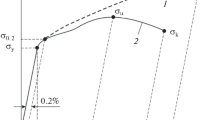Abstract
Wood is one of the few engineering materials for which design codes specify that the applied stress be contingent on the duration of the load. This is in recognition of the fact that the strength of wood appears to degrade with time when under stress. This paper describes a set of experiments in which the kinetics of wood fracture are examined. It is shown that the present results and those of earlier workers can be fully explained by a relatively simple model and mathematical analysis, based on fracture mechanics. According to these results, the delayed failure of wood is caused by subcritical crack growth. The model helps to reveal what must be done to incorporate the duration-of-load effect into timber design in a probabalistic manner.
Similar content being viewed by others
References
S. Mindess, J. S. Nadeau andJ. D. Barrett,Wood Sci. 8 (1) (1975) 389.
Idem, ibid. 8 (4) (1976) 262.
C. C. Gerhards, “Effect of Duration and Rate of Loading on Strength of Wood and Wood-based Materials”, United States Forest Products Laboratory, Madison, Wisconsin, Research Paper no. 283.
J. D. Barrett andR. O. Foschi,Canad. J. Civil. Eng. 5 (1973) 505.
Wood Structural Design Data, 1978 edn., National Forest Products Association, 1619 Massachusetts Ave., N.W., Washington, D.C. 13.
R. Spencer, “Rate of Loading Effect in Bending for Douglas-Fir Lumber”, 1st International Conference on Wood Fracture, Banff, Alberta, Canada, August (1978).
A. G. Evans,Int. J. Fract. 10 (1974) 251.
J. E. Ritter Jr andC. L. Sherburne,J. Amer. Ceram. Soc. 54 (1971) 601.
J. E. Ritter Jr, in “Fracture Mechanics of Ceramics”, Vol. 4, edited by R. C. Bradt, D. P. H. Hasselman and F. F. Lange, (Plenum Press, New York, 1978) p. 667.
P. W. R. Beaumont andA. S. Tetleman, The Fracture Strength and Toughness of Composite Materials, in “Failure Modes in Composites”, edited by Istvan Toth, (AIME, 1972) p. 49.
G. C. Sih, P. C. Paris andG. R. Irwin,Int. J. Fract. Mech. 1 (1965) 189.
A. P. Schniewind andR. A. Pozniak,Eng. Fract. Mech. 2 (1971) 223.
W. F. Brown Jr andJ. E. Srawley,ASTM STP 410 (1966) 13.
J. E. Ritter Jr, N. Bandyopadhyay andK. Jakus,J. Amer. Ceram. Soc. 62 (1979) 542.
S. M. Wiederhorn, to be published.
Author information
Authors and Affiliations
Rights and permissions
About this article
Cite this article
Nadeau, J.S., Bennett, R. & Fuller, E.R. An explanation for the rate-of-loading and the duration-of-load effects in wood in terms of fracture mechanics. J Mater Sci 17, 2831–2840 (1982). https://doi.org/10.1007/BF00644658
Received:
Accepted:
Issue Date:
DOI: https://doi.org/10.1007/BF00644658




